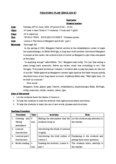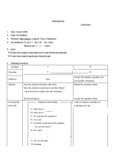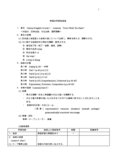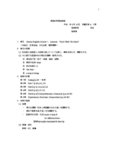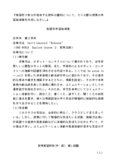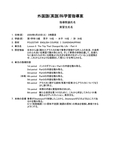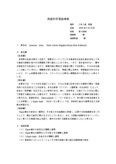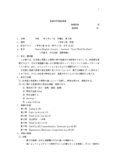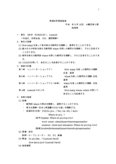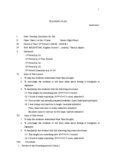連関資料 :: 英語科指導案
資料:27件
-
 英語科学習指導案(英語?)
英語科学習指導案(英語?)
- Aims of this period: 1. Let the students know the theme of Lesson 4. 2. To help the students to read the textbook with right pronunciation and stress. 3. To help the students to learn the use of new words, phrases and structures. Teaching Procedure: Procedure Time Activities Note 1. Greeting and Taking attendance 5 min. Making the atmosphere that the students study in. Let the students pay attention to the teacher. 2. Lesson4 Introduction Introducing the whole of Lesson4 roughly. 3. Lesson4-part1 Introduction Introducing the brief outline of Lesson 4. Explaining to the students and asking them some questions. 4. Model reading 3 min. Reading the textbook, Lesson 4 – part 1 The students listen carefully to the teacher.
- レポート 教育学 教育実習 研究授業 英語? 指導案
 550 販売中 2006/07/13
550 販売中 2006/07/13- 閲覧(3,637)
-
 中学英語科 指導案
中学英語科 指導案
- eaching Plan Instructors: 1.Date: June 27,2005 2.Class: 26 Students 3.Textbook: New Crown 1 Lesspn4 “I Am a Champion” 4.Key sentences: Do you ~? Yes, I do. No, I don’t. What do you ~? I ~. I don’t ~. 5.Aims: ○1To have the students understand how to ask friend’s favorite play. ○2To have the students speak about favorite play.
- レポート 経済学 中学英語 指導案 Teaching Plan
 550 販売中 2006/02/21
550 販売中 2006/02/21- 閲覧(3,300)
-
 英語科学習指導案
英語科学習指導案
- 英語科学習指導案 1.単元 Genius English Course1,Lesson4,”Don’t Work Too Hard.” <対話文、日常会話、文化比較、国際理解> 2.単元の目標 (1) 日本語と他言語との表現の違いについて比較し、興味を持たせ、理解させる。 (2) 次に掲げる言語材料の用法を理解・習得させる。 ? 現在完了形(完了・結果、継続、経験) ? 関係代名詞what ? 形式主語のit ? the way… ? a way of doing 3.指導の計画 第1時 Dialog (p.39) …本時 第2時 Part1(p.40-p.41,l.3) 第3時 Part2 (p.41,l.4-p.42,l.2) 第4時 Part3 (p.42,l.l.3-12) 第5時 Part4 (p.43),Comprehension, Grammar (p.p.44-45) 第6時 Expressions, Exercises, Composition (p.p.46-48) 4.本時の指導(Lesson4,Part2) (1) 目標 ・ 異文化理解…日本と英語圏の文化の違いを理解する。 ・ 文化の差の影響が強いものは決まり文句でも簡単に訳せないときもあることを知る。 ・ 言語材料[文型・文法] It--- to… [語彙] expression(s)/ common/ situation/ instead/ perhaps/ grammatically/ somehow/ encourage
- レポート 教育学 教育法 高校 指導案
 550 販売中 2005/11/05
550 販売中 2005/11/05- 閲覧(3,757)
-
 英語科学習指導案
英語科学習指導案
- 『実習校で自分が担当する教科の題材について、50分間の授業の学習指導案を作成しなさい。』 英語科学習指導案 ①学年 第2学年 ②単元名 Unit1Lesson2“Robocon” (ONE WORLD English Course 2 教育出版) ③単元について (1)単元観 本単元は、ロボット・コンテストについて書かれており、近年目覚しい人間型ロボットの開発、また、中高生によるロボット・コンテストへの理解や認識を深めさせる内容である。ここではbe going to~,willを用いた未来表現と動名詞が中心に扱われており、その基本的な用法や働きを理解させるとともに、場面を設定し、その中で未来表現や動名詞を用いた表現に慣れさせ、コミュニケーションとしての運用能力を高めさせたい。そのため、本文を参考にしてコミュニケーション活動を行い、読むこと、書くこと、話すこと、聞くことの四技能に重点を置き、様々な場面設定の中で生徒が積極的に独創的な表現を作り出させることを期待したい。
- 英語科 学習指導案 指導 実習 英米 英文 科目
 770 販売中 2008/06/30
770 販売中 2008/06/30- 閲覧(5,597)
-
 英語科学習指導案
英語科学習指導案
- 外国語(英語)科学習指導案 指導教諭氏名 実習生氏名 1.日時(仮)2006年6月20日(火) 3時限目 2.学級(仮)第1学年13組男子18名/女子16名/計 36名 3.教材 POLESTAR ENGLISH COURSE ?(SUKENSHUPPAN) 4.単元名 Lesson 6 The Trip That Changed My Life - Part 4 5.設定理由 日本から遠く離れたアラスカの地で筆者が体験する村人との生活、大自然とのふれあいを英語で読み取らせる。そして筆者の体験を通して、生徒たちに自分たちの今いる環境よりも大きな世界が広がっていることを認識させ、これからどのような経験をして見たいかを考えさせる。
- レポート 教育学 指導案 英語 教育実習
 550 販売中 2006/04/26
550 販売中 2006/04/26- 閲覧(3,521)
-
 英語科学習指導案
英語科学習指導案
- 英語科学習指導案 場所 2年2組 教室 日時 2006年6月23日 校時 第4校時 授業者 指導教諭 1.単元名 Lesson4 Ainu (New Crown English Series New Edition2) 2.単元観 【生徒観】 本学級の生徒は明るく元気で、授業をリードしていける意欲的な生徒も数名存在しており普段の授業も和やかな雰囲気で取り組むことができた。一方で、落ち着きがなく、勝手な発言をする生徒もいるので、授業内容に関係する発言に関しては許容し、それ以外は厳しく注意していきたい。理解度の低い生徒にも、英語に関心を持ち、学習意欲が失われないよう、ゲーム的要素を取り入れ、リラックスした明るい雰囲気作りに努めたいと考えている。 【教材観】 本単元では、アイヌ文化を紹介しており、それらを通じ日本の中にも固有の風俗・言語を持つ文化を知ることが出来る。多文化教育(アイヌ)・人間教育(文化保存)によって、生徒の「世界観」を広げることに有効である。
- レポート 教育学 指導案 英語 中学2年 佛大
 660 販売中 2006/06/26
660 販売中 2006/06/26- 閲覧(4,216)
-
 英語科学習指導案 高校
英語科学習指導案 高校
- 1.日時 平成 年6月17日 月曜日 第3限 2.場所 1学年I組 教室 3.担当クラス 1学年I組40名(男子17名、女子23名) 4.単元 Genius English Course1,Lesson4,”Don’t Work Too Hard.” <対話文、文化比較、国際理解> 5.単元・題材観 この章では、日本語と英語との表\現の差や相違点が多数挙げられている。他言語を理解する上で、文化や価値観の違いから表\現が変わってくるということは知っておくべきことである。また、コミュニケーションをとる上でも重要なポイントとなる。 日本語と英語の表\現の差を実際に見てみることにより、異文化理解をずっと深めることができる。さらには生徒の興味を広げ、発展させることのできる題材だと考える。
- レポート 教育学 指導案 高校 ジェスチャー
 550 販売中 2005/10/12
550 販売中 2005/10/12- 閲覧(4,980)
-
 英語科学習指導案 中学
英語科学習指導案 中学
- 1.単元 NEW HORIZON1,Lesson6 <対話文、日常会話、文化、国際理解> 2.単元の目標 (1)How manyを使って数を尋ねる疑問文を理解し、運用することができる。 (2)誰のものか所有を尋ねる疑問詞whoseを用いた疑問文を理解し、それに応答することができる。 (3)場所を尋ねる疑問詞whereを用いた疑問文を理解し、それに応答することができる。 (4) (1)(2)(3)を用いて、身近なことを表\現することができる。 ......4.本時の指導 (1) 目標 ・ 疑問詞whereの用法を理解し、運用することができる。 ・ 異文化理解…日本と英語圏の文化の違いを理解する。 ・ 言語材料[文型・文法]Do you…? Yes, I do. /No, I don’t. Where do you…? [音声]rhythm: Where do you buy tofu? word -stress: often/dinner/where/supermarket sentence -stress and intonation: Where do you buy tofu? [語彙]food/well/often/eat/dinner/where/buy/supermarket (2) 準備・資料 教師…テープレコーダー、PC、FC、辞書 (3) 関連 Do you like…? (Lesson4 Part2) How about you? (Lesson5 Part2) (4) 指導過程 ....
- レポート 教育学 学習指導案 中学校 FC
 550 販売中 2005/10/12
550 販売中 2005/10/12- 閲覧(6,449)
-
 英語科学習指導案 高校
英語科学習指導案 高校
- TEACHING PLAN I.Date: Tuesday, December 25, 200. II.Class: Class 2 in the 1st year. Senior High School. III.Period of Time: 2nd Period (1:20P.M. -2:50P.M.). IV.Text: MILESTONE, English Course1, Lesson2, “Tara in Japan”. V.Allotment VI.Aims of This Lesson VII. Aims of This Period VIII.Procedure 1.Review of the Preceding period (10min.) 2.Presentation of the New Material (20min.) 3.The Reading of the New Material (5min.) 4.Drill of the New Structures and Expressions (13min.) 5.Consolidation (2min.) Comment: また、Listeningの前に3つ質問を与えて、そして後からその答えを生徒に言わせたときには、YesとかThat’s rightなどというだけではなくて、生徒の答え(正しいときはさらに補足を、間違っているときには正しい解答の導き方、どこを見ればわかるのかなどを説明)を使ってそれを再確認しながら答え合わせができるといいと思う。その時、答えは生徒が目でも確認できるように、その都度黒板に板書していくべきであろう。教師が正しい解答の仕方を示すことによって、あとのPair Workでは生徒たちが会話する際に参考になるので、端折ってしまいがちなことではあるけれども、やるべき必須事項に入ってくることだと思う。
- レポート 教育学 指導案 高校 Target
 550 販売中 2005/10/12
550 販売中 2005/10/12- 閲覧(3,167)
